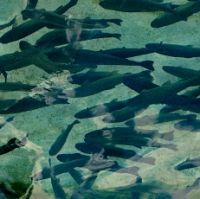

This week (20-26 May) is Invasive Species week, and the Environment Agency has announced the introduction of new technology to help further identify invasive non-native species in UK waters.
The UK is home to over 2000 non-native plants and animals which have originated from all over the world, with many species living in rivers across the UK.
Of those, the Prussian carp and topmouth gudgeon are invasive non-native species that have continued to pose an increased threat to native species through competition for food, hybridisation, and can carry novel parasites and diseases.
Leading the way on developing cutting-edge tools to prevent the spread and control of these invasive species, the Environment Agency's expert team at the National Fisheries Laboratory have recently developed new tool to monitor the DNA shed from fish to help identify their spread and distribution.
By collecting samples of water scientists are then able to tap DNA shed from fish, such as mucus, and use specialised tests to see which fish species are present in the water. The new tool known as eDNA, has allowed the laboratory to investigate the samples from rivers and lakes, and identify the presence of native and non-native species, including the highly invasive species topmouth gudgeon.
The introduction of this method has proven essential to local Environment Agency teams who can now detect and monitor the location of these species. The proven successful management has also highlighted the potential for the method to be used on other invasive species such as the more recently discovered Prussian carp.
Environment Agency Fisheries Manager, Dr Graeme Storey, said: "Invasive non-native species continue to be one of the key threats that our rivers and lakes face, imposing a danger to the survival of our fisheries and a potential harm to the natural environment".
"The work that our National Fisheries Laboratory carries out is critical in making sure we can fully understand and manage invasive, non-native species. Funded by rod license money, their work will ensure that the sport of angling is protected, and the health of our rivers and lakes is improved".
Technical Specialist at the Environment Agency's National Fisheries Laboratory, Dr Gareth D Davies, said: "The Environment Agency’s National Fisheries Laboratory continues to respond to new reports of non-native species, providing identification of suspected non-native fish and development of novel technology to better understand their distribution and the risks they pose to our fisheries".
"We encourage fishery owners, managers and anglers to report any suspected non-native fish captures to us to help us manage the threats these species pose and prevent their further spread".
Anglers, fishery owners, and members of the public are reminded of how they can get involved through reporting suspected sightings of these species to the National Fisheries Laboratory. Since last summer, the number of sights known or suspected to contain Prussian carp has risen from 30 to 37, including the detection of two other non-native species closely related to the species.
Increased reporting by the public has meant that the Environment Agency have been able to place movement restrictions on all waters where the species have been confirmed.
Anglers are also reminded that invasive species can often be small and hard to spot, making it easier for them to spread on damp equipment and clothing. It is therefore recommended that anglers check, clean and dry their clothing whenever they leave the water to reduce the spread.
Any suspected cases of invasive non-native species should be reported to the Environment Agency: